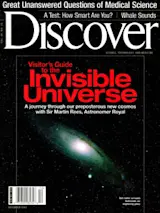A Force to Contend With
Tim Folger’s “Nailing Down Gravity” story in the October issue presents physicist Moti Milgrom’s Modified Newtonian Dynamics, a theory that may explain gravitational anomalies found in large-scale systems such as galaxies. The hypothesis suggests that when gravitational acceleration reaches minuscule levels, gravity ceases to be directly proportional to acceleration and instead becomes proportional to the square of acceleration, causing a slight strengthening in the force of gravity. If gravity’s strength increases at lower accelerations, could the opposite also be true? Could the enormous accelerations surrounding a black hole, for instance, cause gravity there to become weaker, thereby making impossible the formation of a singularity—a point in space-time at which gravitational forces cause matter to have infinite density and infinitesimal volume and cause space-time to become infinitely distorted?
GREGORY CHRISTIE
Sinking Spring, Pennsylvania
Milgrom:
Physics is replete with examples of theories needing amendment when a parameter ...














